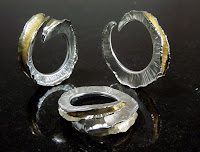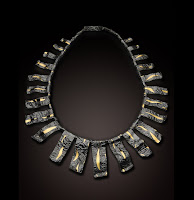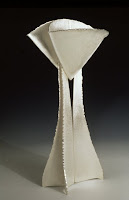 Folded Rings
Folded Rings
I found Cynthia Eid on metalcyberspace which is rapidly becoming one of my favorite sites for viewing spectacular jewelry design and skill. Cynthia’s work first caught my eye with her beautiful and unusual “folded ring” design, but as I got to know her better, I found her personal story and ideas even more interesting. Here’s what she had to say:
You mention on your website that you love the evolutionary transformation of metal…can you talk about this?
I love the way that metal can seem so hard, and yet it can be moved and formed as if it were clay. In fact, when I teach forging and forming metal, I help students understand how to move the metal with a hammer by having them think about how a rolling pin can move clay or dough. I love the paradox that “soft”, fluid-looking metal has evolved from flat, stiff rectangles of metal—-it’s fascinating that a piece can look soft and squishy, but feel hard and unmovable.
Some of my friends like to create in metal by putting forms together. They solve a design problem by adding another element. In contrast, I tend to resolve a design problem by unifying the design, taking away anything extraneous, making it more fluid. I love being able to manipulate metal—-making a single complex form out of one piece of metal without adding any other parts. The folded rings are part of this body of work. I like to use gold/silver bi-metal for these rings. The gold on the inside emphasizes the inside vs. the outside. The gold preciousness enhances the intrigue of the inside. The textured edges catch the lit in a way that is more interesting to me than smooth polished metal. I like to make forms that look like something nature could have made—-yet are not a copy of something in nature. I prefer inventing new forms, rather than faithfully duplicating one of nature’s designs.
From her website, http://www.cynthiaeid.com/, Cynthia’s background is rich in variety and experience:
Cynthia creates jewelry and holloware in her studio in Lexington, MA and teaches Advanced Silversmithing and Jewelry at DeCordova Museum School in Lincoln, MA. She has worked as a designer and maker of custom jewelry in goldsmith galleries, and as designer/modelmaker and production supervisor at a gold jewelry factory. Cynthia began making jewelry in high school. She earned her Master of Fine Arts in Metalsmithing and Jewelry Design from Indiana University in 1980 and a B.S. in Art Education from the University of Wisconsin in 1977.
It seems that many of today’s jewelry designers were first introduced to the metalsmithing in high school. Tell us about those early experiences and what you got out of it that caused you to pursue it as a career.
As a child, my family used to regularly visit my mother’s best friend from college. She was married to a man who was a jeweler/silversmith—Ed Niemi was the head of the jewelry and metals department at the University of Illinois in Normal, IL. I always enjoyed seeing his studio and what he made. I think that knowing him helped make this seem more possible as a career. When I was in junior high, my oldest brother came home with a ring he had made in high school. I remember thinking to myself that if HE could make jewelry, then so could I. I talked my art teacher into getting me some carving wax, and I made two rings that he had cast for me. I spent all my free time hanging out and working in the jewelry studio. The teacher had been there for 40 years or so, and I adored her. I remember the hurt of being hidden behind a partition in the jewelry supply room, and overhearing my jewelry teacher say, “Cindy is a terrific craftsman, but so-and -so is really creative.” Because I loved and respected her so much, I feared that she might be right. For years those words rang in my head, and I strove to prove them wrong. When I teach, I try to remember how intensely my words can either hurt or encourage.
I did not really picture or plan a life as a jeweler or artist. But, I have always made decisions that allowed possibilities, rather than dead ends. For instance, I got a bachelor degree in Art Education, so that I had the possibilities of being a teacher, an artist, or anything that a college degree might be helpful for. At the same time, I always tried to pursue my dreams—-I’d rather try and fail than wonder what would have happened if I had only just tried.
You are also involved in creating Judaica. How does this work differ for you from designing jewelry?
It is intriguing to design works that are aesthetically exciting, are something that I want to make, that fit within my body of work, and yet, the object fulfills a Judaic function. I like to stretch the limits of convention while still making sure that the object will function— for Judaica, and hollowware, as well. I find it particularly satisfying to make ritual objects that will be used by a family in their home or a congregation in their synagogue. It is wonderful to make a piece that will be publicly enjoyed by generations of people.
Your work is part of the permanent exhibit at the Jewish Institute of Religion Museum. You must be proud!
I am, indeed, pleased and proud. I am fortunate that my work resonates for the curator.
What advice do you have for fledgling jewelry designers?
Watch for opportunities. Learn to meet people—-it can be scary, but most people are happy to meet others, especially if you say something nice. Follow up on opportunities. If someone asks you to send them photos, or a resume, do so right away—don’t delay, and don’t forget. Try not to be discouraged by rejections. If you try 5 times, and get rejected 4 times, you have one success. If you try 15 times, and get rejected 12 times, you have 3 successes! Each success tends to lead to another. Opportunities multiply. Make sure that your photos of your work are terrific. More people see the photos than the actual work.
Where can people find your work?
Mobilia Gallery in Cambridge, MA has a lot of my work, and they are the only place that ALWAYS has my work. Libby and Joanne Cooper have supported me in my work for over 20 years. The Cooper family is wonderful—-their grandma used to come in every week to help them. Their sister and mom help out, too. When I brought my parents in to visit, they were treated as esteemed guests. Check my website for other exhibitions and galleries.
It was a great pleasure “meeting” Cynthia through cyberspace. It sounds as though she has found true happiness, spirituality and life balance through her beautiful work.
Thanks for stopping by.
Sally
fortheloveofjewels
Latest posts by fortheloveofjewels (see all)
- Jeweler, Metalsmith, Goldsmith, Silversmith? What are we? - October 16, 2009
- Linda Gebert: Abstracts and Color! - October 16, 2009
- Jay Whaley: Teacher, Toolmaker, Jewelry Master - March 27, 2009
.jpg)



You must log in to post a comment.